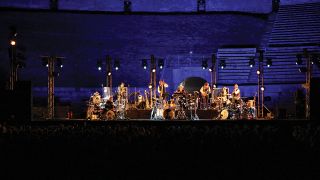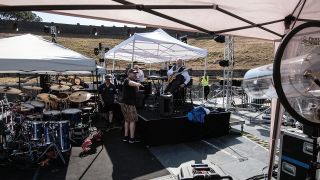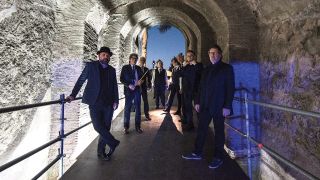Robert Fripp: "In Pompeii, a large percentage of the audience were young couples, and older men were with wives. My own sense and feel of our two audiences: a large proportion seeing Crimson for the first time, a larger proportion seeing this incarnation for the first time.

Starting late as they do in Italy, the sun long since set, the amphitheatre in Pompeii is a stark and haunting place. Echoes abound and rebound, flying off into the night sky. Refurbished by Dave Gilmour so he could play it a couple of years back, it’s nevertheless spartan, if you’ll pardon the Greek rather than Roman allusion. The floor is gravel, the seating basic, the lighting minimal, and the wind whips through the venue. In the afternoon it shook the temporary awnings keeping the blazing sun off the band’s equipment.
The juxtaposition of rock band and ancient Roman arena – though ‘rock band’ doesn’t really convey what the stage looks like, with three sprawling drum kits downstage, Fripp’s guitar cove stage left, mirrored by Mel Collins’ screened-off sax pit – seems entirely fitting with this line-up’s do-or-die musical ambition.
Around midnight in the amphitheatre, the crowd surge forward to sing 21st Century Schizoid Man. Italians young and old, some Americans, sun-bleached Brits and whoever else is there, everyone sings the breaks with Jakko Jakszyk, exultant. He looks like he can’t believe it. Nor can I, to be honest.
There are the dreaded, devilsome camera phones everywhere, though God knows those people are missing out by worrying about filming what is a truly red-blooded moment in a gladiatorial arena – that phone will never capture how it feels, how it sounds as the stars sparkle and the light from the stage glows back on the crowd as the mighty Crim play the song from 49 years ago that started it all.
Night fell long ago. The stars and moon have been alternately serenaded and battered by the melancholy and fury of this band’s latest manifestation. As the audience disperse, spirits are incredibly high. A man behind me keeps saying, “50 years! 50 years!” and clutches my hand. People are high-fiving each other.
Chris Porter, Crimson’s front-of-house sound engineer who has to wrestle all this righteous racket into an orderly noise, is beaming when I tell him how great everything sounded. Truly it’s a Roman triumph. The volcano is in the background, but mercifully it’s King Crimson that erupt tonight.

Robert Fripp: “Last night King Crimson moved into the mainstream in Italy. Alternatively expressed, King Crimson moved out of the prog ghetto… But there’s far more to King Crimson than this. KC is not only a band, clearly so, as there have been nine-ish incarnations. KC is a way of doing things, and its business aims must necessarily reflect its musical aims: a harmony of elements, in tune, in time and in timbre.”

I don’t know about that: to me it seemed to be more the stratosphere that was being bothered that night in Pompeii. As a fan – and I appreciate that what fans want often resembles the artist’s idea of a shit sandwich – I’m not sure I like the idea of Crimson in the mainstream. Not in an “I preferred their early stuff” way; rather I like that when I’m at a show, we and me love this band and don’t care what anyone thinks. But I also sympathise with Fripp’s desire to move out of the prog ghetto. No one likes being pigeonholed, even if they arguably invented the genre they’re boxed in.
I’ve found that describing Crimson as prog is not particularly helpful, given how the band have shed their skin and sound so many times, and while the current manifestation has its fair share of flutey and Mellotron-y moments, so much else is going on besides. Fripp has ventured that King Crimson itself is the genre, and perhaps that’s the better way to get your head around it.
Pompeii – like Graceland – is somewhere I thought I’d get round to visiting but never quite manage. It would have to wait for retirement or, like Graceland, my kids to show an interest (my eldest daughter cried at The King’s grave). So it would take a planetary alignment, a fold in space-time, a lottery win in Latin to get me to Pompeii. That, or King Crimson.
When word reached me last year – and I’m aware that makes it sound like I got a telegram – that Crimson would be playing Pompeii, the diary was cleared, work turned down, Starless left on around the house for rest-of-family brainwashing purposes. Crimson have been a permanent musical presence in my life, sometimes front and centre, sometimes lurking in the background. I’ve often felt the band’s music is something I have to be up to.
Red is the LP that the old houseshare I lived in would spin every Sunday night when we played Risk together, world domination played out to One More Red Nightmare, the vinyl crackling over the start of Providence. Indiscipline became beloved of the crew of sketch comedians I did my first Edinburgh Fringe with, shouting, “I wish you were here to see it!”
When the band reformed in the mid-90s, at a time when anything faintly P-word was regarded as anathema, I dragged friends from both of those scenarios to see Crimson at the Albert Hall. I loved the new stuff, and was as thrilled when they played Red as Frame By Frame. And I’ve also lived through every King Crimson fan’s inevitable Kanye moment: “You know where that’s from, don’t you?”
This latest iteration I’ve seen five times, and with a much bigger and ever-shifting catalogue of material, every show has been grippingly different. The first time I saw this Crim I took my eldest daughter, telling her I never thought I’d see them again so we better go quick while it lasted. That was in 2014, and the circus rolls on…
And this year in Pompeii, downwind of Mount Vesuvius, in the crucible of sulphuric destruction, the city that offers us a vivid lava-clad snapshot of what the end of the world might be like, where better to see King Crimson continue to reinvent their repertoire?

Robert Fripp: “I am myself moved by what acts in and through this band; grateful to be around when Music whispers in our ears; gently noting that, on occasion, what is behind Music accompanies it.”

Repertoire. The repertoire is back. And as Robert Fripp has said, his approach for this sprawling version of Crimson is that all music is new when it is written, and this band address all of the music as though it’s new – turning the more conventional approach of trying to make it sound like the record upside down.
Almost half a century’s worth of music too, some of it only now receiving attention and being heard out loud for the first time, but getting the same treatment as everything else, whichever era it might spring from, Crims Ancient And Modern, fed through the three-drummer, two-guitarist, sax, bass, keyboards mincer.
The personnel, from every phase of the band’s existence and a couple of new ones, add to the sense that Crimson are somehow a musical Möbius strip: you end up where you started. Rather like Jakko Jakszyk, who got into music because of a Crimson show he saw when he was a kid, that has led him to being in Crimson…
But you know all this – of course you do. So what was the show in Pompeii like? I’d stayed in Naples, a city that has the kind of traffic that favours the bold and the reckless: had it been up to me to drive, we would not have left the roundabout at the airport.
Naples is a city that seems to be crumbling at one end and dazzling at the other, a metaphor in search of a subject. Its dark lanes offer real Neapolitan pizza and the opportunity of being knocked over by a moped you had no idea could possibly be there. The juxtaposition of shattered and shiny is unsettling. And everywhere you go, history looms: Vesuvius dominates the bay, lurking in the background.
We were fortunate to stay in the same hotel as the band. There’s something strange about seeing Tony Levin glide by at the breakfast buffet. The band occupy a position of musical celebrity that doesn’t seem to trouble anyone else at breakfast but me. Fripp likes to call Crimson’s shows “hot dates” – none of the band seem to be on the walk of shame at breakfast after the previous night’s show in Pompeii.
What would the set at tonight’s show be? I had lunch with Jakko Jakszyk. “There’s hours of material,” he says, “and the setlist changes every night… you have to be on your toes.”

Robert Fripp: “I walked onstage knowing that this band’s position in the world has changed level.”

So night has fallen, the queue opposite the exhibits of bodies frozen in time have stocked up on cold beers, when Fripp’s pre-show voiceover says, “Let’s have a party!” That’s what people are there to do. However, the good-natured anticipation you might find in a concert hall feels like it has been displaced by a real sense of occasion. A soundscape clangs through the auditorium… the lights come down and through the archway at the back of the stage, the band, backlit by an aura of white light, cast their shadows and make their way down onto the stage.
The band present themselves as if performing a recital, even tuning up like an orchestra – this underlines the idea that this is a body of work we’re there to hear. It just so happens that the orchestra that originated the body of work are going to play it.
Naturally, at the start it’s the three drummers that are the focus: they play as a trio, passing and shifting the beat and bar-line from side to side of the stage. Immediately the character of all three players is on display: Pat Mastelotto’s bat-winged gong hinting at percussive fun and games to come; Jeremy Stacey, eyes down under the brim of his bowler hat, all intensity and whip-snap energy; Gavin Harrison’s languid, all-the-time-in-the-world improbable grooving.
This gives way to Neurotica from Beat, torrid jazz ride cymbal and bass, before the band come in with chrome-shiny chords. This tune played by this band, rather than the Fripp/Belew/Levin/Bruford four-piece it came from, suddenly fits – you hear things you’ll hear later somehow in Pictures Of A City, a tune from another time, another format.
Then we get the newly melodied Indiscipline, which starts with the drummers throwing choked cymbal crashes back and forth, faster and faster, dazzling, immediate, giving way to Jakko’s jazz-inflected melody, matched on his guitar. There’s almost too much to take in at this point and so Crimson engage their repertoire time machine and fire us back to 1971 with Cirkus and Bolero, simmering in the Pompeiian heat, Bill Rieflin’s keyboards summoning ghosts of Mellotrons past.
Fallen Angel and Red follow, a clutch of tunes from Red – we are in the band’s heavy territory for a good 12 minutes, before Epitaph, the band’s end-of-the-world lament, sung in a city long ago destroyed, in an arena for entertainments long since abandoned, from the band’s long-distant founding past, played in its creative present… what else could you want?
Newer music, I suppose, and that’s what we get: Radical Action I and II running into the knotty and powerful Level Five. To my right, across the aisle, a group of Italian lads in their 20s are on their feet and hollering during this tune – this is their era Crim. As Level Five comes to its crash-landing ending, the crowd are ecstatic – this music, difficult, strange music, has moved us too. Islands follows and the band take a break. I’m not sure who it is that needs to get their breath and compose themselves more, us or the band.
The second half of the concert follows a similar pattern, music from different eras building on itself. Discipline, new to this tour, spirals up to the heavens, rolling fives within fives, cosmic geometry; the music of the pentagons. And as the band play Starless and the only lighting effect comes into play, the stage soaked in red light instead of a theatre backdrop behind them, we see the players in blood-red silhouette, the amphitheatre stalls behind them, an image thrown into lurid volcanic 3D.
The show closes with Schizoid Man, and with Gavin Harrison and company reprising a theme from the opening drum trio, we, like the band, are back where we started, a musical Möbius strip, history in the background.
I wish you were here to see it.
This article originally appeared in issue 92 of Prog Magazine.

